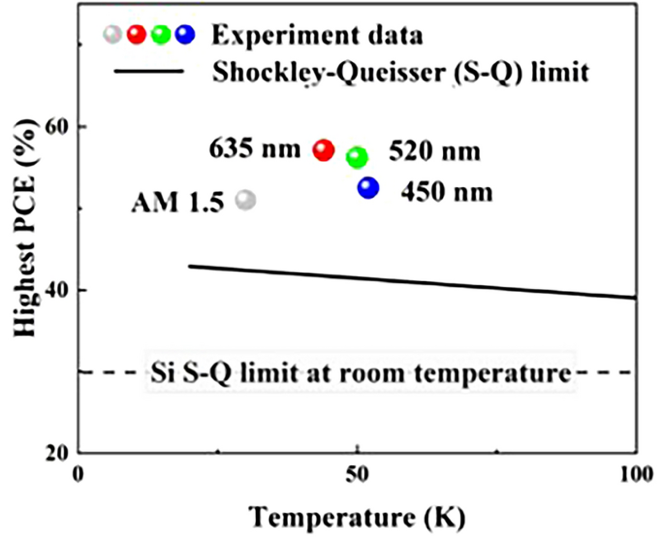
The 33 % Shockley–Queisser (S-Q) ceiling has stood as the ultimate barrier for single-junction photovoltaics since 1961. Now, Prof. Zhigang Li (Taizhou University) and Prof. Bingqing Wei (University of Delaware) report the first experimental breach: n-type monocrystalline Si cells delivering 50–60 % power-conversion efficiency at 30–50 K, effectively doubling the room-temperature record and opening a practical route to cryogenic and deep-space power.
Why Low-Temperature PV Matters
- Freeze-Out Paradox: Below ~150 K conventional cells collapse as carriers become trapped; prior wisdom declared “cooler ≠ better”.
- Thermal-Loss Suppression: Phonon population plummets, hot-carrier cooling slows and VOC can approach the band-gap energy.
- Space & Quantum Applications: Lunar South-Pole rovers, superconducting electronics and quantum sensors demand watt-level power at 30–40 K where sunlight is weak but constant.
Innovative Design & Features
- Cryogenic Hot-Carrier Management: Laser lines tuned 0.1–0.4 eV above Eg generate mobile photocarriers that outrun lattice cooling, raising VOC to 1.1 V (≈ Eg).
- Impact-Ionization Boost: Momentum-conservation rules relax at <50 K; 980 nm photons (≈ Eg) trigger multiple-exciton generation, pushing EQE >140 %.
- Thickness–Penetration Matching: Micro-thin cells (<3 µm) paired with 635 nm light suppress carrier freeze-out while maintaining near-unity absorptivity.
- Intensity-Independent Gain: PCE plateau is robust from 0.01 to 1 sun, enabling star-light harvesting at 2.7 K cosmic-background temperature.
Applications & Future Outlook
- Lunar Polar Missions: Remote light-emitting reflectors on crater rims can wirelessly power mining bots operating in permanent shadow.
- Deep-Space Probes: Star-light PV with 50 % efficiency extends mission life without nuclear sources.
- Next Steps: Team is fabricating 4 cm2 flight-style cells, testing under rapid thermal cycling (20–300 K) and 1 MeV proton irradiation to qualify for NASA Commercial Lunar Payload Services.
This work rewrites the low-temperature PV playbook, turning the once-dreaded freeze-out regime into an ultra-efficiency window—pointing toward >50 % single-junction devices for extreme-environment energy harvesting. Stay tuned for vacuum-chamber and lunar-simulant tests from the Wei–Li joint lab!
Follow the Topic
-
Nano-Micro Letters

Nano-Micro Letters is a peer-reviewed, international, interdisciplinary and open-access journal that focus on science, experiments, engineering, technologies and applications of nano- or microscale structure and system in physics, chemistry, biology, material science, and pharmacy.






Please sign in or register for FREE
If you are a registered user on Research Communities by Springer Nature, please sign in